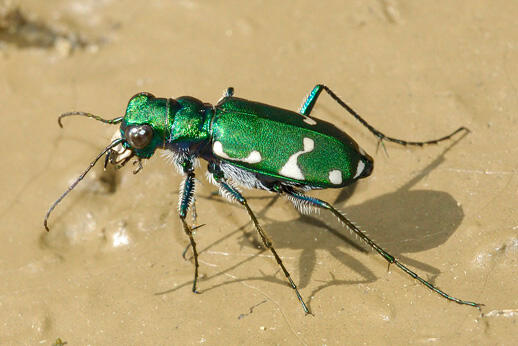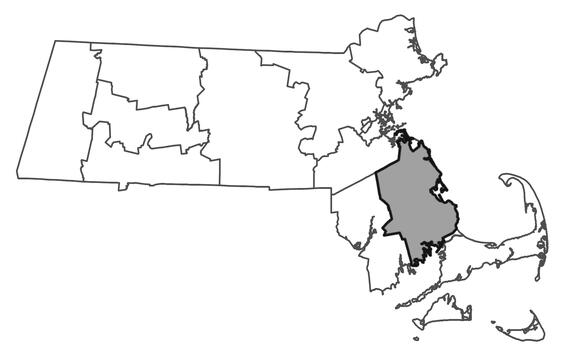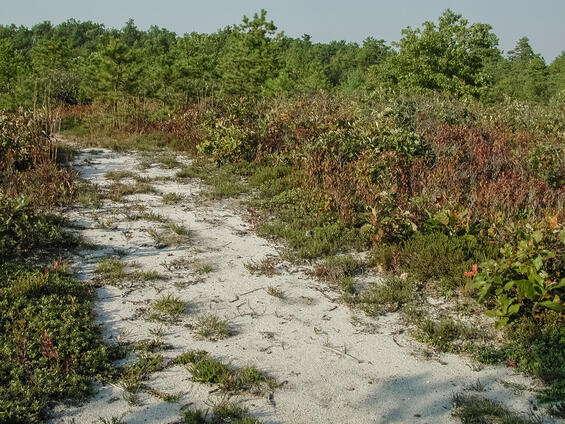- Scientific name: Cicindela patruela
- Species of Greatest Conservation Need (MA State Wildlife Action Plan)
- Endangered (MA Endangered Species Act)
Description

Barrens tiger beetle (Cicindela patruela)
Tiger beetles are so named because of their “tiger-like” behavior of chasing down and capturing prey with their long mandibles. The barrens tiger beetle (Cicindela patruela) is 13-15 mm (0.5-0.6 in) in length (Pearson et al. 2015), with an iridescent green body and white maculations (markings) on the elytra (wing covers). The six-spotted tiger beetle (Cicindela sexguttata) is similar, but the white maculations on the elytra are reduced to six spots around the outer edge, with no middle band like the barrens tiger beetle.
Life cycle and behavior

The barrens tiger beetle has a two-year life cycle. Adult beetles emerge in late August and September, entering diapause in October and overwintering. From late April through early June, the adults mate, and the females lay eggs. Eggs hatch soon after they are laid, and larvae feed until the fall, spending the first winter in larval diapause. Larvae resume feeding in the spring and complete development by late August or September.
Distribution and abundance
The barrens tiger beetle is found from southern New Hampshire south to North Carolina, and west to Minnesota and northern Georgia; populations are rare and localized throughout this range (Pearson et al. 2015). In Massachusetts, this species is only known to occur in Plymouth County.

Distribution in Massachusetts. 2000-2025. Based on records in the Natural Heritage Database.
Habitat
In Massachusetts, the barrens tiger beetle occurs in sparsely vegetated openings in sandplain pitch pine-scrub oak barrens. This species requires patches of bare sand, where adult beetles forage and mate, and where larval beetles construct burrows and capture prey.
Healthy habitats are vital for supporting native wildlife and plants. Explore habitats and learn about conservation and restoration in Massachusetts.

Sandplain pitch pine-scrub oak barrens with bare sand, habitat for the barrens tiger beetle.
Threats
The barrens tiger beetle is threatened by habitat loss and suppression of fire, which is needed to maintain the open vegetation structure of its habitat. Off-road vehicles kill adult beetles and larvae by crushing them, as well as cause extensive habitat damage by rutting consolidated sand, rendering it unsuitable for larval burrows. Aerial insecticide spraying is a potential threat. The effect of a warming climate may not be detrimental to this species in Massachusetts; its range extends south to Georgia, suggesting adaptation to warm temperatures.
Conservation
Land protection and habitat management are the primary conservation needs of the barrens tiger beetle in Massachusetts. In particular, sandplain pitch pine-scrub oak barrens should be conserved, restored, and managed to maintain habitat for this species and the entire suite of rare and threatened species dependent on such habitat.
Survey and monitoring
The distribution of the barrens tiger beetle in Massachusetts is well documented. The Plymouth County population of this species should be surveyed to document persistence at least once every 25 years; every 10 years is more desirable when practicable.
Management
Management of sandplain pitch pine-scrub oak barrens benefits a suite of rare and threatened species, and habitat condition should be monitored and management adapted as needed. For the barrens tiger beetle, pine barrens with sparsely vegetated openings and patches of bare sand are of particular importance.
Research needs
The natural history and conservation needs of the barrens tiger beetle are relatively well understood. However, the future effects of a warming climate on this species are unpredictable and should be documented.
References
Pearson, D.L., C.B. Knisley, D.P. Duran, and C.J. Kazilek. 2015. A Field Guide to the Tiger Beetles of the United States and Canada. Oxford University Press, New York, New York. 251 pp.
Contact
| Date published: | April 15, 2025 |
|---|